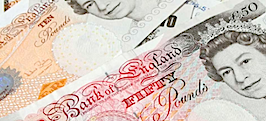Interest payments on UK central government debt were £8.1 billion in December 2021, a December record and £5.4 billion more than in December 2020, according to the UK’s Office for National Statistics (ONS).
The ONS said the UK government’s debt currently stands at £2.34 trillion.
The £8.1 billion was the second-highest monthly interest payment on record and is almost certain to rise amid soaring retail price inflation.
“The recent high levels of debt interest payments are largely a result of movements in the Retail Prices Index (RPI) to which index-linked gilts are pegged,” said the ONS.
The UK’S Public sector net borrowing excluding public sector banks (PSNB ex) was estimated to have been £16.8 billion in December 2021 — the fourth-highest December borrowing since monthly records began but £7.6 billion less than in December 2020.
PSNB ex was estimated to have been £146.8 billion in the financial year-to-December 2021 — the second-highest financial year-to-December borrowing since monthly records began in 1993 but £129.3 billion less than in the same period the previous year.
Public sector net debt excluding public sector banks (PSND ex) was £2.34 trillion at the end of December 2021 or around 96.0% of gross domestic product (GDP), the highest ratio since March 1963 when it was 98.3%.
Public sector net debt excluding public sector banks and the Bank of England (PSND ex BoE) was £2.01 trillion at the end of December 2021 or around 82.7% of GDP.
Provisional December 2021 estimates by the ONS indicate that UK central government receipts were £68.5 billion, up £6.2 billion or 10% on December 2020, while UK central government bodies spent £84.7 billion, down £1 billion or 1.2% on December 2020.
Laith Khalaf, head of investment analysis at AJ Bell said: “Money flowing out of public sector continues to comfortably exceed the cash coming in, to the tune of £16.8 billion in December.
“Despite the high figure, the dials are generally heading in the right direction from the peak of the pandemic, albeit not as quickly as the Chancellor might like.
“Central government tax revenues rose by 10% year on year, boosted by low levels of unemployment, even in the aftermath of the furlough scheme.
“Meanwhile expenditure came in lower than last December, but only just, because interest payments on government debt trebled compared to last December, to £8.1 billion, a record for the month.
“That’s because higher inflation has pushed up the cost of government bonds that are pegged to RPI, costing the government £5.5 billion in December 2021.
“With price rises still coming down the track, inflation is going to continue to bump up the coupons paid by the government to holders of RPI linked bonds, so this won’t be a flash in the pan.
“To add considerable fuel to the fire, interest rates are rising, which means the government will have to pay more interest on the £875 billion of gilts held with the Bank of England.
“And if that were not enough, gilt yields have shot up, to over 1% on the 10 year bond, which means the government will also be paying more for freshly issued debt than before the pandemic.
“With the debt to GDP ratio sitting at 96%, the highest level since the 1960s, the Chancellor is still wedged in a tight spot after the pandemic has ravaged the nations finances.
“The good news is so far this financial year, public sector borrowing is coming in below OBR forecasts.
“The bad news is the government is facing calls to help out with the cost of living crisis, including pressure to postpone the new Health and Social Care Levy, which is expected to raise £12.7 billion in the coming financial year.
“That would leave a sizeable hole for the Chancellor to fill in his March Budget.
“Two months is of course a very long time in politics, and given the political turmoil in Westminster, we can’t even be sure who will be delivering the Budget when March rolls around.
“We can be more certain that the pressure on government finances will be considerable.”
